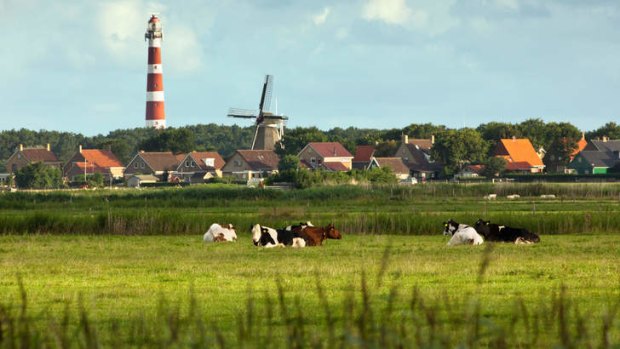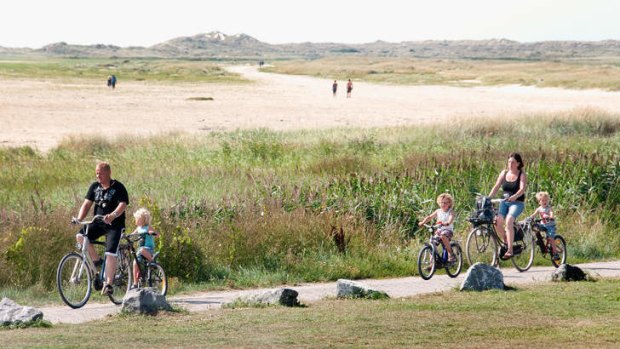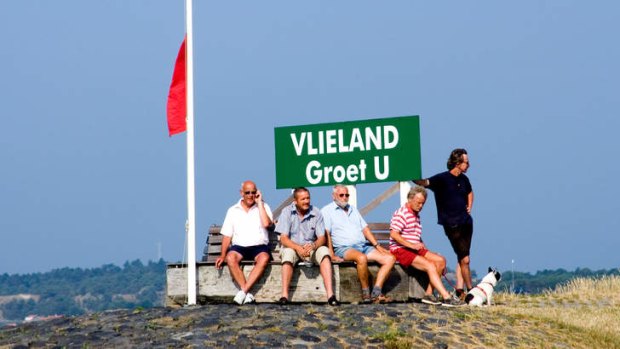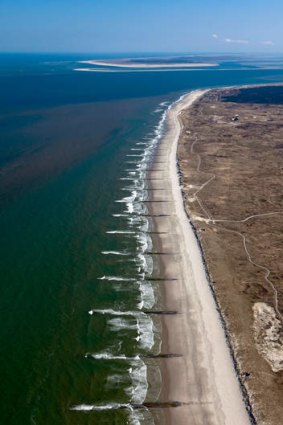
Sandy isles: Hollum, on Ameland Island by the Wadden Sea.Credit: Alamy
Sue Joseph learns how to lollop along like the holidaying locals on the sandy West Frisian isles.
Watching the Dutch ride bicycles is a cultural shock to a Sydney-sider. In the towns, cyclists make up an integral part of the traffic - they do not have to battle it, fighting to survive as they do in Sydney. They attach their smaller children to themselves in harnesses, or in trailers before or after their bikes. Their older children have their own bikes, and cycle alongside, with the traffic and around it. They wear no helmets, and appear not in a rush, merely lolloping along on their big-wheeled cycles.
I watch them, side by side, chatting away as if sitting in a car. It is spring. but I am told they cycle the same, in any weather.

Family cycling on Terschelling Island.Credit: Alamy
It is what the Dutch do. So it is inevitable that I will end up on a bicycle at some point, travelling with my Dutch partner's family.
It is a family reunion - my partner with his two sisters, brother-in-law, three nephews and niece - on a remote sandy island just off the northern coast of the Netherlands. The Wadden Sea on one side laps at the dike, and the North Sea is on the other. There are kilometre after kilometre of grass-covered sand dunes, backing onto 12 kilometres of beach. It stretches as far as I can see. This is Vlieland (pronounced flee-lond), one of seven sandy West Frisian islands strung along this northern Dutch coastline.
Only the locals are allowed cars on this island, so we arrive off the huge ferry after a one hour and 45 minute crossing from Harlingen.

Dutch welcome at Vlieland.Credit: Alamy
The wind is howling and white caps cover the water. We are met by family with a tiny blue painted, hand-drawn cart. I wonder out loud what it is for.
We have to carry the bags to our house, the Dutchman's sister says.
Where is the house? I ask, looking around me.

Vlieland's long beach faces the North Sea.Credit: Alamy
About 35 minutes away, straight across the island, she says.
Thirty five minutes?! Isn't there a taxi? Nee, she laughs, as we pile the bags on the cart and set off on foot.
Backing right up against the village is a wood. We follow a white path made of shells which leads us deeper and deeper into the middle. The setting is pure gothic Grimm fairy tale. When we reach the other side of the forest, I see a white-washed, A-line house nestled in a sand dune between bushes of beautiful flowers and trees. I can hear the sea rumbling just over the dune. It sounds huge and menacing. Coupled with the howling wind, I wonder how much of this place I am even going to get to see, as the rain sets in.
There is only one village on Vlieland, called Oost-Vlieland; the rest of the island is covered in lush woods and forests, dunes, meadows and scrubland, with a main road around and 26 kilometres of fietspaden (cycle paths) throughout. There are no English translations of anything, no English-speaking tourists. There are a few German tourists - the rest are Dutch. The village is one main, tree-lined road, full of restaurants full of Dutch food and retail shops, full of Dutch goods. All the businesses are small and quaint. There are many cafes and cycle hire shops.
This is where the Dutch holiday in summer , swimming in the North Sea, playing on the beaches, walking, cycling, flying kites - and playing board and card games. When the weather closes in, the games come out. Families play for hours, drinking tea, laughing and fighting to win. And so do we.
Before this trip to Vlieland, nestled between the islands of Texel and Terschelling, the Dutchman was intent on showing me another sandy island of his childhood, further east. Ameland (pronounced arma-lond). The trip over is an extraordinary experience and sight. This is the Wadden Sea at low tide - our gigantic ferry, called Oerd, travels slowly through the channel, winding around massive expanses of mudflats, getting shallower as the tide recedes, sucked back into the North Sea. It takes just 45 minutes to get from the mainland to one of four villages on the island. And on this island, we can take our car. The villages sound like Tolkien dreamings - Hollum, Ballum, Buren. And uniformly, they all look like tiny fairytale towns - ancient and quaint, and too impossibly neat and tidy.
Again, this is not a regular tourist destination but a Dutch family secret, kept for themselves. And a few Germans.
We find a hotel nestled among the sand dunes, just out of Buren. The Strandhotel is modern and warm, friendly and quiet, and we are a mere 50 metres from the beach and the North Sea. I almost feel the ground tremble as the waves roll onto the beach.
We are both quiet, looking out towards the beach, which stretches 27 kilometres along the northern side of this island. It is covered in grey, silt-like fine sand.
It is a continuous government programme, maintaining the sand along these strips of island coastline. More than 12 million cubic metres of sand a year are collected from the bottom of the North Sea, far off shore, and carried back to the coastline, and dumped here at differing distances from the shore to prevent these islands from disappearing. Huge tankers that suck the sand from the sea bottom work continuously to shore up these shores.
There are two gas platforms on the horizon and the sea is a mossy green colour, topped with white caps. The wind is whipping and lifts the sand in wraith-like whisperings, just up from the waterline. It is stunning in its stark beauty and never ending-ness. But back to the cycling. Much of the island of Vlieland, like the other sandy islands in the strip, is a bird sanctuary and this is how I end up on a bicycle.
We wake to brilliant sunshine the next day. The wind has dropped away completely. It somehow feels like the eye of the tornado to me - I am overly aware of the immensity of the North Sea, just a few hundred metres away, waiting to thunder and pound the beaches again.
Let's get bikes and try to find the lepelaars, the Dutchman says. Lepelaars are spoon-billed, long-legged birds, distant cousins to the ibis.
Because there are no predators on the sandy islands, they breed here annually. The word for spoon in Dutch is lepel, and I have only ever seen photographs in books so readily agree and we set off.
Firstly, we get lost. There are many small fietspaden, criss-crossing the island, like so many little veins and arteries, leading in and out of its heart. We head back from where we came and find ourselves deep in the heart of the woods again. Suddenly, there is a clearing and up above us is a lighthouse.
I lie on the grass and look at the sky and close my eyes and listen to the silence. And then I hear it - a crystal birdsong, up high in the trees, away in the distance.
That's the koekoek vogel, the Dutchman tells me. Of course, the cuckoo. And it is a true, authentic coo-cuu sound. I realise it is a sound I have never heard before in the wild.
I say to the Dutchman, this is good. Beautiful, he says simply.
And now for the lepelaar. We are yet to sight one, and feel we cannot return home until we do. So we cycle. And cycle. And cycle, until my legs smart and my back aches. We hit the main road behind the dike and the forest, and keep cycling.
Suddenly, I see one. Then two. Then three pairs, wading through the shallow Wadden, sweeping their spoon-like beaks backwards and forwards, sieving the watery mudflats for food, intent on nothing else. We stop. I hear the bell-like crystal sounds of the cuckoo drifting through the wood behind us. The Wadden Sea is gentle and calm today, and the tide is going out, revealing the micro-world of the mudflats - perfect lepelaar feeding time. They move fast along the coastline, wading and spooning.
We can go home now, says the Dutchman. I realise that this means more cycling.
I wake in the early hours of the next morning with legs on fire. I have never felt muscle distress like I do now. I am scared to move and wonder how I will even walk the next morning.
But the Dutchman has a solution.
We cycle some more, around this sandy island, watching more birds, listening to the sea, exploring the dunes and the forests.
And I realise I am holidaying just like the Dutch. And it is good.
Sign up for the Traveller Deals newsletter
Get exclusive travel deals delivered straight to your inbox. Sign up now.